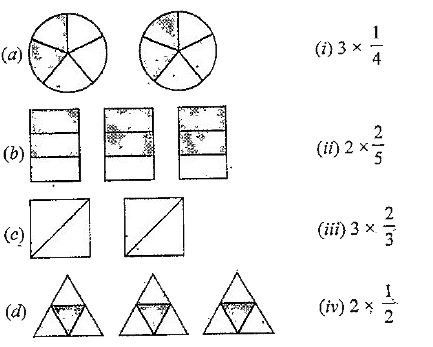Solve the following :
13 of
(a) 15 (b) 27 (c ) 32 Solution in Punjabi
The correct Answer is:115
Step by step video, text & image solution for Solve the following : (1)/(3) of (a) (1)/(5) (b) (2)/(7) (c ) (3)/(2) by Maths experts to help you in doubts & scoring excellent marks in Class 7 exams.
Updated on:21/07/2023Topper's Solved these Questions
- FRACTIONS AND DECIMALSBOOK - SWAN PUBLICATIONCHAPTER - FRACTIONS AND DECIMALSEXERCISE - EXERCISE 2.3 (Multiple choice questions)
3 Videos
- FRACTIONS AND DECIMALSBOOK - SWAN PUBLICATIONCHAPTER - FRACTIONS AND DECIMALSEXERCISE - EXERCISE 2.4
26 Videos
- FRACTIONS AND DECIMALSBOOK - SWAN PUBLICATIONCHAPTER - FRACTIONS AND DECIMALSEXERCISE - EXERCISE 2.2
21 Videos
- EXPONENTS AND POWERS BOOK - SWAN PUBLICATIONCHAPTER - EXPONENTS AND POWERS EXERCISE - OTHER IMPORTANT QUESTIONS (TRUE FALSE)
8 Videos
- INTEGERSBOOK - SWAN PUBLICATIONCHAPTER - INTEGERSEXERCISE - OTHER IMPORTANT QUESTIONS (III. State whether the following statements are true or false : )
8 Videos
Similar Questions
14 of 83 is
View SolutionFind the reciprocal of each of the following fraction.
27
View SolutionMatch the following :

View SolutionWhich of the statement is true and which is false
If a any non zero rational number then a0=a.
View SolutionZero is an integer which is neither positive nor negative.
View SolutionSolve 112+227=312+? (a)2/3 (b) 2/7 (c) 5/8 (c) 7/2 (e) 1/7
View SolutionThe value of |[a,a+d,a+2d] , [a+d,a+2d,a+3d] , [a+2d,a+3d,a+4d]|+|[b
View SolutionHow many of the following alkyl halides would react by SN1 mechanism?
CH3Br,CH3CH2Br,CH3CH2CH2I,(CH3)3CBr,BrCH3CH=CH2,C6H5CH2Br,(CH3)3CCH2Br,C6H5CHBrCH3,CH3CH=CHCH2Cl.
 .
.
View SolutionThe SN1 reactivity of the following halides will be in the order:
(i) (CH3)3C−Br
(ii) (C6H5)CHBr
(iii) (C6H5)2C(CH3)Br
(iv) (CH3)2CHBr
(v) C2H5Br
View SolutionChoose the chain terminating step
(1) H2→H⋅+H⋅
(2) Br2→Br⋅+Br⋅
(3) Br⋅+HBr→H⋅+Br2
(4) H⋅+Br2→HBr+Br⋅
(5) Br⋅+Br⋅→Br2
View SolutionIn CH_(3)CH_(2)Br,% of Br is
View SolutionPredict all order of reactivity of the following compounds in dehydrohalogenation. a,. I. CH_(3)CH_(2)CH_(2)CH_(2)Cl II. (CH_(3))_(2)CHCH_(2)Cl III. (CH_(3))_(2)CH - CH_(2)Br IV. CH_(3)CH(Br)CH_(2)CH_(3) V. (CH_(3))_(3) C - Br b. I. CH_(3)CH(Br)CH_(3) II. CH_(3)CH_(2)CH_(2)Br III. (CH_(3))_(2) CH - CH_(2) Br IV. (CH_(3))_(3)C - CH_(2) Br
View Solutionनिम्नलिखित यौगिकों में विहाइड्रोहेलोजनीकरण के प्रति क्रियाशीलता का क्रम बताइए ।
(a) CH3CH2CH2CH2Cl, (CH3)2CHCH2Cl, (CH3)2CH−CH2Br, CH3CH(Br)CH2CH3,(CH3)3C−Br
(b) CH3CH(Br)CH3,CH3CH2CH2Br, (CH3)2CH−CH2Br, (CH3)3C−CH2Br
View SolutionS1N तथा S2N अभिक्रिया में निम्नलिखित यौगिकों की क्रियाशीलता का क्रम कारण सहित बताइए -
(i) ब्रोमोब्यूटेन के चार समावयवी
CH2−CH2−CH2C∣BRH2, CH3−C∣BrH−CH2−CH3, (CH3)2CH−C∣BrH2, (CH3)3C−Br
(ii)C6H5CH2Br, C6H5CH(C6H5)Br, C6H5CH(CH3)Br, C6H5C(CH3)C6H5Br
View Solutionहल कीजिएः
(a).23+17 (b).310+715 (c).49+27 (d).57+13
View SolutionWhich of the following haloalkanes have low boiling point ? Give reason.
(a) CH3CH2CH2CH2Br
(b) CH3CH2CHCH3 | Br
(c ) CH3 |H3C−C−CH3 | Br
View Solution
